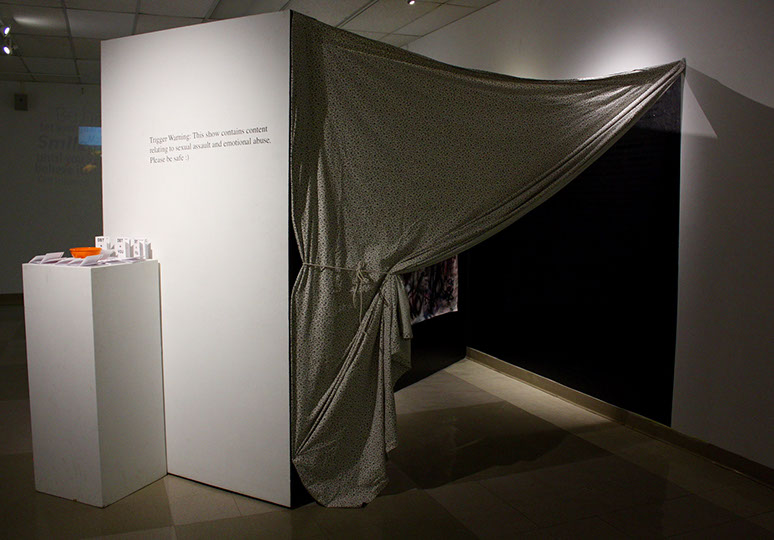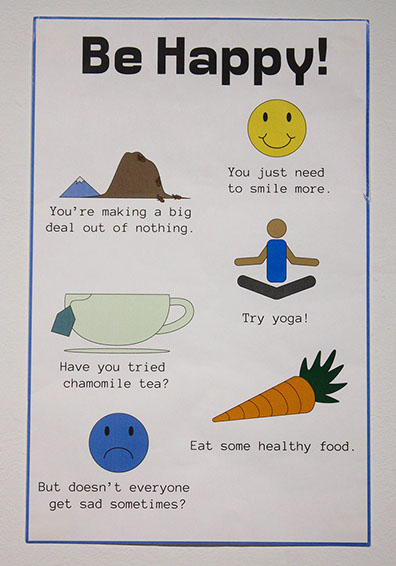Gallery 5 Show Allows Visitors to Confront their Traumas
By Sara Frazier
Before September, Danielle Dinstman (CFA’18) and Selina Gerosa (CFA’18) had no idea that they would be working together to create a gallery show. Last week, their collaborative multimedia exhibition Trauma Center was on display at Gallery 5 and proved to be a smash hit.
As the deadline passed to submit a Gallery 5 show application, Danielle, a painter, and Selina, a graphic designer, found themselves in the same boat: they wanted to have a gallery show, but it no longer seemed like a possibility. Then Jackey West, the Administrative Coordinator in the College of Fine Arts, had the unconventional idea to pair them together for a joint gallery show.
“Both of them expressed interest to me at the beginning of the semester in having a Gallery 5 show,” West said. So she told both students that if they were interested, they could create a show together. “From there they were able to figure it out in a relatively quick amount of time, and expressed a lot of confidence that they felt like they had themes that were complementary.”
Dinstman and Gerosa actually met during their freshman year orientation. However, they noted that different majors within CFA are fairly separated, so they had not been in contact since.
“I messaged Selina and was like, ‘This is going to sound crazy, but are you around this weekend to get together and talk about this?’” Dinstman said. “So we went to Pavement and we basically started talking about just what our work talks about.”
Over a cup of coffee, they realized that their work overlapped seamlessly. Gerosa, a graphic designer who approaches their work from an “emotionally abusive space,” and Dinstman, a painter who tackles issues of sexual abuse, decided to create a show about how people process trauma. “Through the lens of sort of a doctor’s waiting room, we’re creating a space in which you can experience that trauma and maybe process it and move forward,” Gerosa explained.
To help viewers process the trauma, the artists printed out DBT, or Dialectical Behavioral Therapy, pamphlets. Inside the pamphlets are an explanation of the therapy—“DBT is all about learning to live in the moment with, rather than cure, mental illness.”
After picking up a pamphlet, visitors will have their eyes drawn to a large painting of bright blue blobs that fit together almost like puzzle pieces. Dinstman’s rendering of “abstract, biomorphic forms” has a sexual nature to it, and elicits feelings of intimacy and closeness.
Almost hidden on the walls of the gallery is white vinyl with passive aggressive phrasing. Sentences like “You’re getting upset over nothing,” and “It’s okay to be a failure!” demonstrate the unhelpful ways that some people try to approach others’ trauma. Similar phrasing is found on posters throughout the gallery. One poster with “Be Happy!” printed across the top offers a not so helpful suggestion for someone who has been traumatized by something: “Have you tried chamomile tea?”
“The conception of space is sort of the way that people will talk to you like, ‘get over it’ or ‘toughen up,’” Gerosa said. “That phrasing can get conflated with actual help.”
In addition to ironic motivational phrases, the exterior mimics a doctor’s office waiting room, fully equipped with a mini playroom. A toy truck, a multi-color xylophone, a bead maze and a heart-shaped yellow pillow lay atop an eclectic quilt, creating a sense of playfulness and fun.
In the internal trauma center, however, this illusion of joy is quickly shattered. For those who may not feel emotionally equipped to see the interior trauma space, a trigger warning outside the curtain explains that the material inside is sensitive. “I think having the curtain does talk about consent in a way,” Dinstman said. “Once the viewer opens up the curtain they are consenting to going into that space.”
Beyond the curtain are two deeply emotional, upsetting works. Red, blue and purple paints are smeared across a white canvas, spelling out words that cry for help—“STOP,” “NO,” “WHAT ARE YOU DOING?” The work appears as desperate pleading, and may upset some viewers. Equally disturbing is a transcript of an appeal decision from the Boston University concerning a sexual assault case, stating that they are not pursuing further action. The vinyl type blacks out some words to show that this situation could happen to anyone, anywhere. “This happens all the time where they’re like, ‘We don’t know who to believe so we’re not going to do anything,’” Gerosa said. “That’s not a way forward.”
The artists hoped to create a place where people can relate and sympathize with the feelings of processing trauma--in this, they have definitely succeeded. “It should certainly be relatable. Whether or not you’ve dealt with the same kinds of trauma we have, the feelings are very similar,” Gerosa said. “I think people will get it. Whether or not it leaves a lasting impression is up to them.”
For more information and images from these artists, please visit danielledinstman.com and selinagerosa.com.
Photos courtesy of the author.



